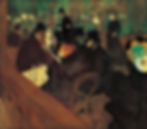by Alexandra Tuschka
This section of the picture is truly unusual. Where to look? A lady, bluishly lit, is looking at us on the right, but she is cut off from the edge of the picture. She, after all, makes eye contact with us. The sloping wooden balustrade separates us from the rest of the action, we stand in front of it. From our position, we have a good view of a group of people positioned around a table. We are probably not invited. Only from behind can we make out a lady's fancy purple costume, her hat is also sweeping and adorned, the hair underneath done up with much effort. To her right sit two top-hat wearers. The first is smiling animatedly, the second, with a moustache, looks somewhat absent-minded. Opposite him sits a lady with an even more conspicuous hat; her face is a little confused, is she practising a bedroom look? Finally, to her left, another fine gentleman has put down his walking stick, he has left his red gloves on straight away. His profile view reveals a monocle.

Four more people, equally chic, enliven the background. Two more men strive to the left into another room, which is only hinted at. Dimly, we recognise more guests and a dancer as well as a glass or mirrored door on the left.
The Moulin Rouge, in which we find ourselves here, was a favourite subject of the painter Henri Toulouse-Lautrec. Not only did he enjoy spending time there and living nearby, but a business arrangement solidified this connection. Toulouse-Lautrec was commissioned by the Moulin Rouge to design a series of posters advertising the club. Because of this commission, the Moulin Rouge always kept a place free for him. The painter's style is composed of many different impulses: At the age of 19, he was still classically trained, but then opened himself up to the influences of the Impressionists. His love of Art Nouveau and his knowledge of the lithographic technique are also unmistakable in his works.

The quivering Parisian nightlife attracted him, as it did many other artists. "Au Moulin Rouge" is one of his greatest paintings and shows the inner life of the amusement arcade. Different classes met here - dancers, artists, the common people mingled with the bourgeois crowd. Toulouse - Lautrec chose an unusual format - almost a square. With the help of comparative works, we can identify some of the people quite clearly: The lady on the right turns out to be May Milton, a dancer adored by the painter but unfortunately unsuccessful. the lady opposite quite clearly represents the "Macarona", a Spanish dancer who performed regularly at the Moulin Rouge. She was immortalised once again by Toulouse-Lautrec in a jockey costume. And the red lady can also be identified as Jane Avril, despite her back view. Her red hair appears in many other works by the painter. "La Goulue", Louise Weber, with her blonde hair and high chignon, directs herself in the mirror in the background. The men at the table are, on the left, Édouard Dujardin, a literary and music critic, easily recognisable by his long, wavy beard, monocle and walking stick; next to him, Paul Sescau, a photographer. The French painter worked closely with him as he made reproductions of his works, and on the right Maurice Guibert, a winemaker. But there is another subtlety hidden in the two men in the background. The diminutive Toulouse-Lautrec is depicted here next to his tall and slender cousin Gabriel Tapié de Céleyran as they stroll through the establishment. With the other two gentlemen in top hats, another diagonal is drawn, copying the composition of the balustrade. Is this an inviting scene? Do we want to sit here and toast?

All the people in the picture illustrate a phenomenon that Toulouse-Lautrec expresses masterfully - the lack of contact. If we look at the lines of sight of the people, we notice that they do not meet, no one speaks, no one laughs. Only the grotesque woman in front looks at us; but her gaze is difficult to interpret. The light supports an artificial and almost threatening impression through the garish and unnatural colours. This was probably also the opinion of the buyers, so that Toulouse-Lautrec or his broker cut away the woman without further ado in order to be able to sell it better. In 1914, however, this section was added back to the painting.
Edgar Degas, a friend and contemporary of the painter, also depicted these two sides in his painting "Absinthe", in which the finely trimmed lady has to confront the dullness of her existence. On the one hand, the obvious togetherness and, on the other, complete isolation. In our main picture - as here - a decanter stands on the table and conveys a hospitable and convivial impression. However, Toulouse-Lautrec, who was also friends with many dancers, will have known that the friendliness of a bar society is not always authentic and that the wild, cheerful Parisian nightlife also has darker sides. He himself was also affected by alcoholism and experienced the dark side of nightlife first-hand.
Henri de Toulouse-Lautrec - Au Moulin Rouge
Oil on canvas, 1892-1895, 1.23 m x 1.41 m, Helen Birch Bartlett Memorial Collection, Chicago
Edgar Degas - The Absinthe
Oil on canvas, 1875/76, 92 x 68.5 cm, Musée d'Orsay in Paris



